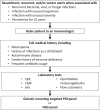Consideration of underlying immunodeficiency in refractory or recalcitrant warts: A review of the literature
- PMID: 35665206
- PMCID: PMC9060099
- DOI: 10.1002/ski2.98
Consideration of underlying immunodeficiency in refractory or recalcitrant warts: A review of the literature
Abstract
Although the exact mechanisms have yet to be elucidated, it is clear that cellular immunity plays a role in clearance of human papillomavirus (HPV) infections as it relates to the development of warts. Patients with extensive, recalcitrant, or treatment-refractory warts may have an underlying immune system impairment at the root of HPV susceptibility. Early recognition of genetic disorders associated with immunologic defects that allow for recalcitrant HPV infection may expedite appropriate treatment for patients. Early recognition is often pivotal in preventing subsequent morbidity and/or mortality that may arise from inborn errors of immunity, such as WHIM (Warts, Hypogammaglobulinemia, Infections, Myelokathexis) syndrome. Among these, cervical cancer is one of the most common malignancies associated with HPV, can be fatal if not treated early, and is seen more frequently in patients with underlying immune deficiencies. A review of diseases with susceptibility to HPV provides clues to understanding the pathophysiology of warts. We also present diagnostic guidance to facilitate the recognition of inborn errors of immunity in patients with extensive and/or recalcitrant HPV infections.
© 2022 The Authors. Skin Health and Disease published by John Wiley & Sons Ltd on behalf of British Association of Dermatologists.
Conflict of interest statement
Zampella reports receiving consulting fees from X4 Pharmaceuticals. Cohen has no conflict of interest to declare.
Figures
References
-
- Cubie HA. Diseases associated with human papillomavirus infection. Virology. 2013;445:21–34. - PubMed
-
- Luria L, Cardoza‐Favarato G. Human papillomavirus. In: StatPearls [Internet]. StatPearls Publishing; 2021. Accessed 8 Mar, 2021. Available from: https://www.ncbi.nlm.nih.gov/books/NBK448132/
Publication types
LinkOut - more resources
Full Text Sources

